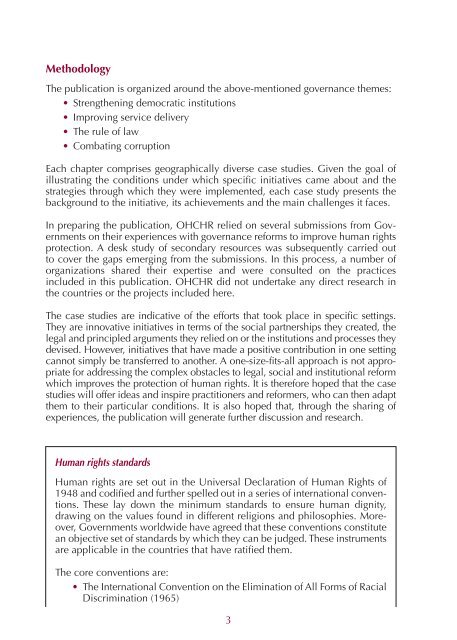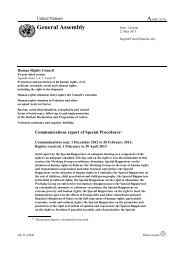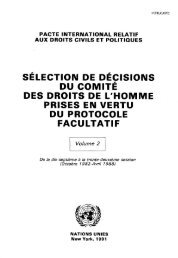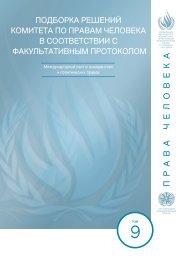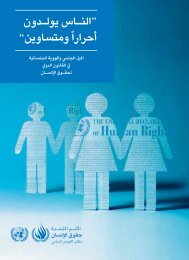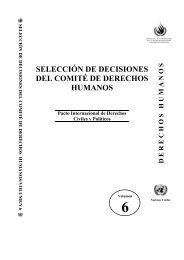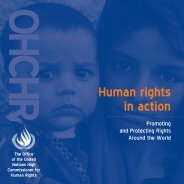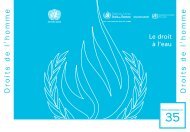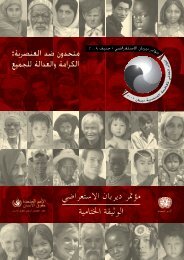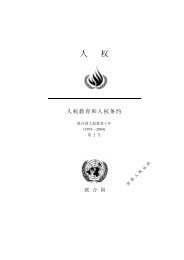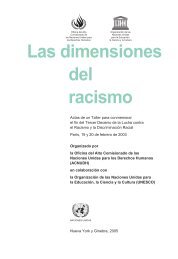good governance practices for the protection of human rights
good governance practices for the protection of human rights
good governance practices for the protection of human rights
You also want an ePaper? Increase the reach of your titles
YUMPU automatically turns print PDFs into web optimized ePapers that Google loves.
Methodology<br />
The publication is organized around <strong>the</strong> above-mentioned <strong>governance</strong> <strong>the</strong>mes:<br />
•<br />
•<br />
•<br />
•<br />
Streng<strong>the</strong>ning democratic institutions<br />
Improving service delivery<br />
The rule <strong>of</strong> law<br />
Combating corruption<br />
Each chapter comprises geographically diverse case studies. Given <strong>the</strong> goal <strong>of</strong><br />
illustrating <strong>the</strong> conditions under which specific initiatives came about and <strong>the</strong><br />
strategies through which <strong>the</strong>y were implemented, each case study presents <strong>the</strong><br />
background to <strong>the</strong> initiative, its achievements and <strong>the</strong> main challenges it faces.<br />
In preparing <strong>the</strong> publication, OHCHR relied on several submissions from Governments<br />
on <strong>the</strong>ir experiences with <strong>governance</strong> re<strong>for</strong>ms to improve <strong>human</strong> <strong>rights</strong><br />
<strong>protection</strong>. A desk study <strong>of</strong> secondary resources was subsequently carried out<br />
to cover <strong>the</strong> gaps emerging from <strong>the</strong> submissions. In this process, a number <strong>of</strong><br />
organizations shared <strong>the</strong>ir expertise and were consulted on <strong>the</strong> <strong>practices</strong><br />
included in this publication. OHCHR did not undertake any direct research in<br />
<strong>the</strong> countries or <strong>the</strong> projects included here.<br />
The case studies are indicative <strong>of</strong> <strong>the</strong> ef<strong>for</strong>ts that took place in specific settings.<br />
They are innovative initiatives in terms <strong>of</strong> <strong>the</strong> social partnerships <strong>the</strong>y created, <strong>the</strong><br />
legal and principled arguments <strong>the</strong>y relied on or <strong>the</strong> institutions and processes <strong>the</strong>y<br />
devised. However, initiatives that have made a positive contribution in one setting<br />
cannot simply be transferred to ano<strong>the</strong>r. A one-size-fits-all approach is not appropriate<br />
<strong>for</strong> addressing <strong>the</strong> complex obstacles to legal, social and institutional re<strong>for</strong>m<br />
which improves <strong>the</strong> <strong>protection</strong> <strong>of</strong> <strong>human</strong> <strong>rights</strong>. It is <strong>the</strong>re<strong>for</strong>e hoped that <strong>the</strong> case<br />
studies will <strong>of</strong>fer ideas and inspire practitioners and re<strong>for</strong>mers, who can <strong>the</strong>n adapt<br />
<strong>the</strong>m to <strong>the</strong>ir particular conditions. It is also hoped that, through <strong>the</strong> sharing <strong>of</strong><br />
experiences, <strong>the</strong> publication will generate fur<strong>the</strong>r discussion and research.<br />
Human <strong>rights</strong> standards<br />
Human <strong>rights</strong> are set out in <strong>the</strong> Universal Declaration <strong>of</strong> Human Rights <strong>of</strong><br />
1948 and codified and fur<strong>the</strong>r spelled out in a series <strong>of</strong> international conventions.<br />
These lay down <strong>the</strong> minimum standards to ensure <strong>human</strong> dignity,<br />
drawing on <strong>the</strong> values found in different religions and philosophies. Moreover,<br />
Governments worldwide have agreed that <strong>the</strong>se conventions constitute<br />
an objective set <strong>of</strong> standards by which <strong>the</strong>y can be judged. These instruments<br />
are applicable in <strong>the</strong> countries that have ratified <strong>the</strong>m.<br />
The core conventions are:<br />
• The International Convention on <strong>the</strong> Elimination <strong>of</strong> All Forms <strong>of</strong> Racial<br />
Discrimination (1965)<br />
3


